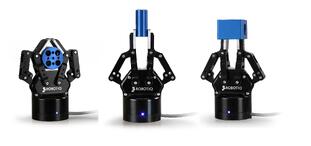Robotic Tool Changers: Top 5 Problems

Robotic tool changers are used on robots to change end effectors so one robot can do multiple tasks. It can enable switching between grippers or other end-of-arm tools (such as a finishing tool or welding gun). A robotic tool changer is composed of two sides that are used to standardize the interface between the robot wrist and the different robot tools. This article presents the 5 main problems of using tool changers on a robot to switch between different grippers.
1. Cycle Time
For most robotics application you want to reduce the cycle time to increase your return on investment. If you often use a robotic tool changer, the robot has to stop working to change the tool. Every time the robot stops to change the end-of-arm tool, it is not adding value to the process and increases the cycle time.
2. Cell Space
If you use a robotic tool changer, you need a place to put all the different grippers. This takes some valuable space on your layout that again is not adding value. If you start from scratch, that might not be too bad. But if you need to fit the cell in a standard pre-engineered robotic cell enclosure, you lose the standard solution and pay for the custom layout.
3. Stacking at the Robot Wrist
Motors at the robot's joints have a given torque. Anytime you add to the length of an arm, the payload that you can handle diminishes. This problem becomes even more important if you increase the payload with high acceleration. Tool changers add space between the end of the robot arm and the tool; which reduces the effective payload.
4. Gripper Finger Design Time
If you are using a tool changer to switch from different grippers, it means that you are designing several custom fingers to handle the different parts geometry. This gripper customization needs man power and prototyping, adding to the total project cost.
5. Long Term Flexibility
Point 4 is true at the initial system design time. However, you are most likely to introduce parts in your process in the future. In that case, the customization of the gripper finger design will happen again.
Robotic tool changers are definitely useful to switch between different types of end-of-arm tools. If you only need to switch between grippers, you do want to look at the Robotiq’s Adaptive Gripper. Its flexibility removes the need for a tool changer and eliminates the problems stated above.







Leave a comment